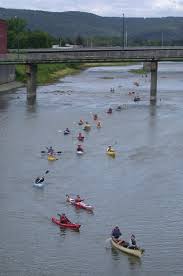Don’t blame our rivers for floods
Fifty years ago, Hurricane Agnes came inland, stalled over the Northeast and dumped biblical amounts of rain, causing the Flood of June 1972, an epic natural disaster that has haunted the Twin Tiers ever since. This year marks the 50th anniversary of that flood.
I was 17 years old that summer and about to start my senior year at Southside High School in Elmira. The flood changed my life, the future of Elmira and the public’s views of the Chemung River.
The 45-mile waterway begins in Corning, at the confluence of the Cohocton and Tioga rivers, and flows into the Susquehanna River in Athens, Pa., which also flooded. The river eventually flows into the Chesapeake Bay. During the flood, the Chemung and Susquehanna took lives, destroyed towns and swept away houses, cars, bridges and even cattle in their powerful and muddy downhill rampage.
For the folks who had to suffer through the flood and rebuild their lives, the rivers became evil incarnate, and scapegoats to blame for all the pain, sorrow and destruction wrought by a once-every- 100-years flood.
The problem is the rivers didn’t cause the flooding; the hurricane and rain did. A river is simply the lowest and easiest downhill route for water to travel, in the local topography.
The rain and melting snow on the hills and valleys flow to that low spot that we call a river, and transport it downhill to the oceans. Rivers are nature’s drains and sump pumps. Without them we would be up to our wet behinds in floods every time it rains.
That’s why it is so important to understand how a river works and how to partner with it for a safe and healthy environment.
A river’s floodplains, those flat expanses of vegetation, forests and soil abutting the waterways, slow down the water, spread it out and let it soak into the soil instead of flooding our communities. Healthy and well-maintained floodplains and wetlands are nature’s flood insurance and habitats for fish, birds, other wildlife and vegetation.
Photos provided - Jim Pfiffer. (Left to right) Scenic view of the tranquil and beneficial Chemung River; Canoers enjoy paddling on the Chemung River, which winds through small towns, cities and bucolic woodlands.
But most of those floodplains and wetlands have been drained, paved over, developed and erased. Now the rainwater has nowhere to sit and gradually seep back into the water cycle. Instead, it overflows banks, causing erosion, property damage and floods.
The Tioga-Hammond dams, built after the 1972 flood, helped reduce the Chemung River and its tributaries, but nothing can completely prevent flooding. The dams won’t stop another major flood if we’re hit with another Agnes-like hurricane.
That becomes more likely as global warming evaporates more moisture into the air, increases rain and snow falls, and energizes hurricanes and tornadoes.
We are to blame for the flooding. We build homes and businesses in flood plains, drain wetlands and pave over soil and vegetation that soaks up water. That requires us to build levees and floodwalls and dredge streams to try and control our waterways.
Rivers don’t like being told what to do. They have been doing what they do for millions of years. I think they got it down pat by now.
That’s why we have to work with rivers in partnership instead of trying to change their behavior.
Today, the rivers in the Twin Tiers are cleaner, safer and less flood-prone than they were before 1972, thanks to better anti-pollution laws and work by organizations like Chemung River Friends, and county soil and water conservation districts.
That’s good because rivers provide water for agriculture, industry and outdoor recreation. More than 50 percent of Elmira’s drinking water comes from the Chemung River. Our waterways make for great outdoor classrooms and places to watch wildlife and commune with nature.
The federal Environmental Protection Agency said that the Chemung River and its tributaries are the cleanest of all the waterways that feed into the Chesapeake Bay. We can keep it that way through intelligent development and reducing climate change.
Planting trees is one of the best ways to do just that. Trees capture and store climate-warming carbon. They soak up rain, prevent erosion, cool cities and parks, and make great places for tire swings and tree houses. They say that the best time to plant a tree was 20 years ago. The second-best time is now.
As we glide into summer and enjoy our waterways, remember the role that you play in protecting them from us. Our lives depend on it.
What you can do to protect our rivers and reduce flooding
Use biodegradable cleaning products and earth-friendly body products. Those chemicals go down the drain and back into our rivers.
Reduce the use of chemical insecticides and herbicides and fertilizers on your lawns, as rainfall washes them into our waterways.
If you wash your car at home, do it on the grass, instead of the driveways, so the detergents can be soaked up and rendered harmless by the grass and other vegetation.
Use rain barrels and rain gardens to capture and slow rainfall to reduce flooding and erosion.
Work with elected officials to reduce the destruction of floodplains and wetlands.
Don’t dump your grass cuttings and other yard debris along streams and rivers. They will wash into the waterways and pollute the water and cause damming and water flow.
Don’t litter. Pick up and dispose of trash and litter that ends up in our waterways, which pollutes our water and kills wildlife.







Comments